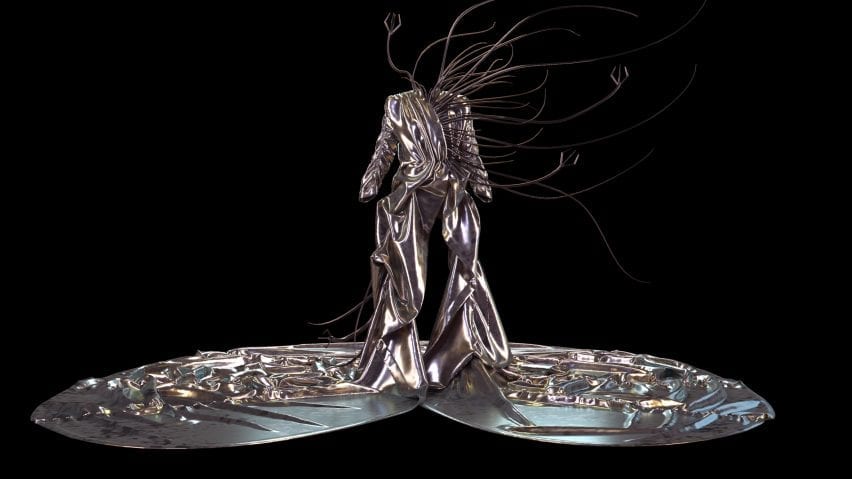Digital fashion house The Fabricant and designer Toni Maticevski have created the Animator Overcoat, a piece of unisex virtual haute couture that is decorated with claw-like spikes.
Dubbed "digi-couture," the Animator Overcoat is a purely digital garment with protruding spikes and a cascading train that resembles molten metal and takes cues from 1999 science-fiction film The Matrix.
The garment was available for visitors to virtually try on at Australian Fashion Week, where they were digitally dressed by the team from DressX.
The digital fashion retailer produces virtual clothes that can be worn in photographs.
Visitors to the show were photographed in the Animator Overcoat by a fashion photographer and then received a digital asset of themselves wearing the virtual clothing.
"It's an experience in which everybody can be front row," co-founder of The Fabricant Amber Jae Slooten told Dezeen.
"Normally, if you go to a fashion show, you're looking at it but you're not really a part of it. For us, it was important that anybody could be a part of this if they wanted to be."
Dark and spiky in appearance, the Animator Overcoat's design was informed by sea urchins, but was also designed to carry a message about the perceived hostility of digital spaces.
"A sea urchin looks very hostile from the outside but from the inside, it's actually quite soft, and I think the intention with this dress is to create that hostility," said Slooten.
"It's very much inspired by this idea of hostility and the fact that the digital space often looks quite hostile," she continued. "We were thinking about how the experience contrasts with this, and we really love that."
It was important to The Fabricant and Maticevski that their garment be deliberately gender-neutral, as the designers wanted the experience of virtually wearing the overcoat to be inclusive and empowering.
The designers implemented this by creating a wide garment that they felt would fit various bodies, featuring elements such as broad shoulders.
By giving visitors the opportunity to experience virtual fashion at a physical fashion show, The Fabricant and Maticevski hoped to encourage conversations about the potential of virtual dressing.
"Making more physical clothes is not the answer," urged Slooten, who advocates for people to reduce the amount of clothes they own in order to minimise waste.
"We should look for new ways to dress ourselves," she added.
"I feel like if people go through this experience in a physical space, and really feel what it is to wear something virtual, they understand the meaning of it and the implications, and they can start reducing their own closet to stuff that's more practical."
"Then, with virtual dressing, you can go to any event with a super extravagant look," Slooten concluded.
The Animator Overcoat was launched by Afterpay, the global payments platform that sponsored Australian Fashion Week.
Other virtual fashion projects include The Fabricant's flaming virtual trainers, designed in collaboration with shoe brand Buffalo London, and a Balenciaga collection that was launched as a video game.
Images are courtesy of The Fabricant.

